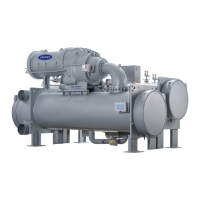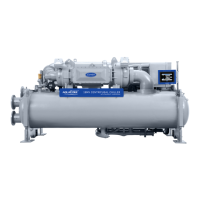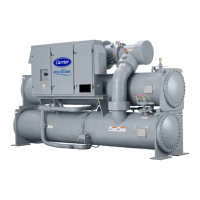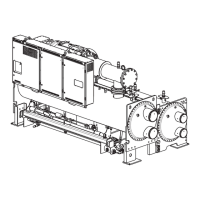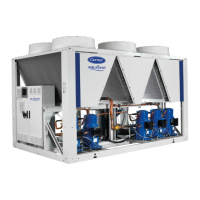5
INTRODUCTION
Prior to initial start-up of the 23XRV chiller, those involved
in the start-up, operation, and maintenance should be thorough-
ly familiar with these instructions and other necessary job data.
This book is outlined to familiarize those involved in the start-
up, operation and maintenance of the unit with the control sys-
tem before performing start-up procedures. Procedures in this
manual are arranged in the sequence required for proper chiller
start-up and operation.
ABBREVIATIONS AND EXPLANATIONS
Frequently used abbreviations in this manual include:
Words printed in all capital letters or in italics may be
viewed on the International Chiller Visual Controller (ICVC)
(e.g., LOCAL, CCN, ALARM, etc.).
Words printed in both all capital letters and italics can also
be viewed on the ICVC and are parameters (e.g., CONTROL
MODE, COMPRESSOR START RELAY, etc.) with associated
values (e.g., modes, temperatures, percentages, pressures, on,
off, etc.).
Words printed in all capital letters and in a box represent
softkeys on the ICVC control center (e.g., , ,
, , etc.).
Factory-installed additional components are referred to as
options in this manual; factory-supplied but field-installed ad-
ditional components are referred to as accessories.
The chiller software part number of the 23XRV unit is lo-
cated on the back of the ICVC.
23XRV CHILLER FAMILIARIZATION
(FIG. 1-7)
Chiller Identification Nameplate —
The chiller
identification nameplate is located on the right side of the
chiller control center.
System Components — The components include
cooler and condenser, heat exchangers in separate vessels,
motor-compressor, lubrication system, control center, and
optional economizer.
CAUTION
This unit uses a microprocessor control system. Do not
short or jumper between terminations on circuit boards or
modules; control or board failure may result.
Be aware of electrostatic discharge (static electricity) when
handling or making contact with circuit boards or module
connections. Always touch a chassis (grounded) part to
dissipate body electrostatic charge before working inside
control center.
Use extreme care when handling tools near boards and
when connecting or disconnecting terminal plugs. Circuit
boards can easily be damaged. Always hold boards by the
edges and avoid touching components and connections.
This equipment uses, and can radiate, radio frequency
energy. If not installed and used in accordance with the
instruction manual, it may cause interference to radio com-
munications. The chiller control boards have been tested
and found to comply with the limits for a Class A comput-
ing device pursuant to International Standard in North
America EN 61000-2/3 which are designed to provide rea-
sonable protection against such interference when operated
in a commercial environment. Operation of this equipment
in a residential area is likely to cause interference, in which
case the user, at his own expense, will be required to take
whatever measures may be required to correct the interfer-
ence.
Always store and transport replacement or defective boards
in anti-static shipping bag.
CCM — Chiller Control Module
CCN — Carrier Comfort Network
®
CCW — Counterclockwise
CSM — Chillervisor System Manager
CW — Clockwise
DPI — LF2 VFD Drive Peripheral Interface Board
ECDL — Entering Condenser Liquid
ECL — Entering Chilled Liquid
EMS — Energy Management System
EXV — Electronic Expansion Valve
HGBP — Hot Gas Bypass
ICVC — International Chiller Visual Controller
IGBT — Insulated Gate Bipolar Transistor
I/O — Input/Output
KAIC — Kiloamps Interrupt Capacity
LCD — Liquid Crystal Display
LCDL — Leaving Condenser Liquid
LCL — Leaving Chilled Liquid
LED — Light-Emitting Diode
LEI — Local Equipment Interface Translator
LF2 — Reliance LiquiFlo™ 2 VFD with Active
Rectifier
OIM — Reliance Operator Interface Module
OLTA — Overload Trip Amps
PIC III — Product Integrated Control III
RLA — Rated Load Amps
RS485 — Communications Type used by ICVC and
CCM
SCR — Silicon Controlled Rectifier
SI — International System of Units
SIO — Sensor Input/Output
TB1 — Control Center Terminal Block 1
TB2 — Control Center Terminal Block 2
VFD — Variable Frequency Drive
VFG — Variable Frequency Gateway Module

